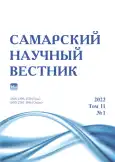Some introduction aspects of genus Hoya plants in greenhouse conditions
- Authors: Turbina I.N.1
-
Affiliations:
- Surgut State University
- Issue: Vol 11, No 1 (2022)
- Pages: 124-127
- Section: Biological Sciences
- URL: https://journals.rcsi.science/2309-4370/article/view/108333
- DOI: https://doi.org/10.55355/snv2022111116
- ID: 108333
Cite item
Full Text
Abstract
The paper deals with the study results of genus Hoya adaptive capabilities in protected ground conditions. The objects of the study are four species and one cultivar of the genus: Hoya cumingiana Decne., Hoya globulosa Hook. f., Hoya australis R. Br. ex Traill, Hoya pubicalyx Merrill, Hoya cv. Metallica. In culture, the life cycle of plant development corresponds to the natural one with minor periods of dormancy in autumn and winter associated with a reduction of daylight hours and insolation. For all introduced species, an increase of chlorophyll content and ratio of chlorophyll to flavonoids in the autumn period and minor fluctuations of flavonoids throughout the entire study period were noted, which indicates their relatively optimal nitrogen status. The author has revealed species specificity in the accumulation of chlorophyll and flavonoids and nitrogen balance. The shoot system is characterized by a plagiotropic growth direction and all its vegetative areas are structurally homogeneous. Each single-order stephanotis shoot grows at the top of the stem, shoots can be both short- and long-chamber. Intensive growth and decorativeness of the shoot system of H. globulosa, H. cumingiana and H. pubicalyx, the stability and plasticity of the photosynthetic apparatus provide the prospect of their use in phytodesign.
Full Text
##article.viewOnOriginalSite##About the authors
Irina Nikolaevna Turbina
Surgut State University
Author for correspondence.
Email: scilla3@yandex.ru
candidate of biological sciences, senior researcher of Scientific and Educational Center of Natural and Technical Sciences Institute
Russian Federation, Surgut, Khanty-Mansi Autonomous Okrug – YugraReferences
- Averyanov L.V. et al. Hoya in Cambodia, Laos and Vietnam // Turczaninowia. 2017. Vol. 20, № 3. P. 103-147. doi: 10.14258/turczaninowia.20.3.10.
- Madani I., Ali L.I., Nur E.El. Evidences from morphological investigations supporting APGIII and APGIV classification of the family Apocynaceae Juss., nom. cons. // European Academic Journal of Biological Diversity. 2017. Vol. 11, № 4. P. 187-193. doi: 10.13057/biodiv/d110404.
- Baltazar A.M.P., Buot I.E. Controversies on Hoya R. Br. Taxonomy // The Thailand Natural History Museum Journal. 2019. Vol. 13, № 1. P. 59-68.
- Cabactulan D.D., Rodda M., Pimentel R. Hoya of the Philippines part I. Hoya migueldavidii (Apocynaceae, Asclepiadoideae), a new species from Northern Mindanao, Philippines // PhytoKeys. 2017. Vol. 80. P. 105-112. doi: 10.3897/phytokeys.80.12872.
- Forster P.I., Liddle D.J. Hoya R. Br. (Asclepiadaceae) in Australia - an alternative classification // Austrobaileya. 1990. Vol. 3, № 2. P. 217-234.
- Rodda M. Two new species of Hoya R. Br. (Apocynaceae, Asclepiadoideae) from Borneo // PhytoKeys. 2015. Vol. 53. P. 83-93. doi: 10.3897/phytokeys.53.5079.
- Pham T.V., Averyanov L.V. New species from Vietnam - Hoya lockii (Apocynaceae, Asclepiadoideae) // Taiwania. 2012. Vol. 57. P. 49-54.
- Kloppenburg R., Guevarra M.L.D., Carandang J.M., Maranan F.S. New species of Hoya R. Br. (Apocynaceae) from the Philippines // Journal of Nature Studies. 2012. Vol. 11, № 1&2. P. 34-48.
- Nazar N. Phylogenetic relationships in Apocynaceae based on both nuclear and plastid molecular datasets: dis. … dr of philosophy in plant sciences. Islamabad, 2012. 130 p.
- Алексейчук Я.Д., Керимова Н.А. Современные направления озеленения общественных интерьеров // Ландшафтная архитектура, строительство и обработка древесины: мат-лы науч.-техн. конф. СПбГЛТУ по итогам НИР 2017 года. Санкт-Петербург, 15-16 февраля 2018 г. / отв. ред. И.А. Мельничук. СПб.: Санкт-Петербургский политехнический университет Петра Великого, 2018. С. 72-74.
- Грищенко Е.Н., Волкова В.В. Интродукция субтропических и тропических лиан в оранжерее Ставропольского ботанического сада им. В.В. Скрипчинского // Плодоводство и ягодоводство России. 2016. Т. XXXXVI. С. 78-81.
- Шаплыка М.А., Турбина И.Н. Опыт вегетативного размножения некоторых видов рода Hoya R. Br. в условиях закрытого грунта // Тенденции развития науки и образования. 2017. № 29-3. С. 44-47. doi: 10.18411/lj-31-08-2017-50.
- Шеметова И.С., Шеметов И.И., Васильева С.Е. Видовой состав комнатных растений для экофитодизайна учебных заведений // Вестник Иркутского государственного аграрного университета. 2016. № 76. С. 91-96.
- Tungmunnithum D., Kidyoo M., Khunwasi C. Morphological variations in Hoya siamica Craib (Asclepiadaceae) in Thailand // Tropical Natural History. 2011. Vol. 11, № 1. P. 29-37.
- Martin C.E., Hsu R.C., Lin T. Sun shade adaptations of the photosynthetic apparatus of Hoya carnosa, an epiphytic CAM vine, in a subtropical rain forest in northeastern Taiwan // Acta Physiologiae Plantarum. 2010. Vol. 32, № 3. P. 575-581. doi: 10.1007/s11738-009-0434-9.
- Medina M., Amoroso V., Kloppenburg R. Changes of leaf morphology of Hoya amorosoae from varying light exposure: its implications to species description and taxonomy // Journal of Biodiversity and Environmental Sciences. 2016. Vol. 8, № 6. P. 232-237.
- Пьянков В.И., Иванов Л.А., Ламберс Х. Характеристика химического состава листьев растений бореальной зоны с разными типами экологических стратегий // Экология. 2001. № 4. С. 243-251.
- The Plant List [Internet] // http://www.theplantlist.org/1.1/browse/A/Apocynaceae/Hoya.
- Wanntorp L., Meve U. New combinations in Hoya for the species of Clemensiella (Marsdenieae, Apocynaceae) // Willdenowia. 2011. Vol. 41, № 1. P. 97-99. doi: 10.3372/wi.41.41110.
- Смирнова Е.С. Методика наблюдений за растениями в интерьерах // Бюллетень ГБС. 1980. Вып. 117. С. 36-40.
Supplementary files










